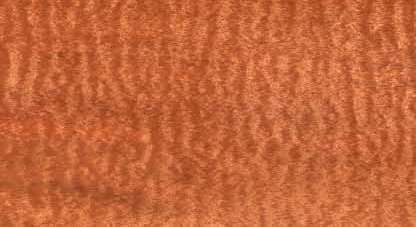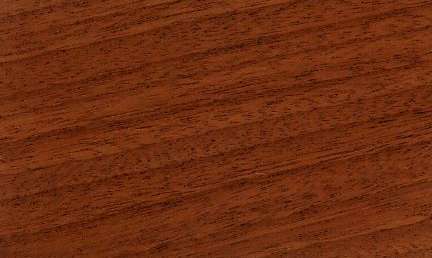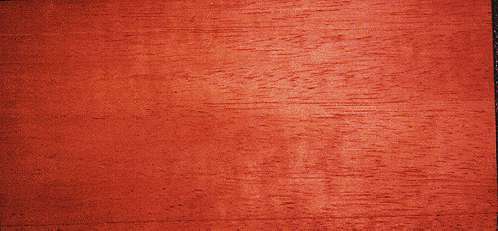  
African mahogany (Khaya grandifoliola)
Family: Meliaceae
Common names: Acajou, Acajou grandes feuilles, African mahogany, Akor, Akuk, Apenkwa, Appapayi, Asamogo, Bandoro, Benin mahogany, Big leaf mahogany, Bogu, Diala-iri, Digiten, Diki, Dirinshi, Dubini, Dukru, Dukuma, Dumanami, Eri, Eri kire, Eri kiree, Gadeau, Gagaliga, Heavy African mahogany, Homraya, Khaya mahogany, Kruba, Krubna, Loukrou, Male, Mario, Munyama, Murraya, Obon, Odala, Oduben, Odupon, Oganwo, Ogwango, Ono, Senegal mahogany, Tiama-tiama, Tido, Trio, Upono, Wansanwa, Wausauwah
Distributed in: Benin, Cameroon, Congo, Ghana, Guinea, Ivory Coast, Nigeria, Sudan, Tanzania, Togo, Uganda, Zaire (Africa)
Distribution overview: West tropical Africa from the Guinea Coast to Cameroon and extending eastward through the Congo basin to Uganda and parts of Sudan (Benin, Cd'Ivoire, DR Congo, Ghana, Guinea, Nigeria, Sudan, Togo, Uganda). Often found in the fringe between the rain forest and the savanna, in dry semi-deciduous forest or rocky forest and forest outliers.
Common uses: Balusters, Bedroom suites, Boat building (general), Boat building, Boat building: decking, Building construction, Building materials, Cabinetmaking, Canoes, Carvings, Construction, Decorative veneer, Domestic flooring, Drawer sides, Drum sticks, Excelsior, Factory flooring, Figured veneer, Flooring, Furniture , Furniture, Heavy construction, Interior construction, Interior trim, Joinery, Kitchen cabinets, Lifeboats, Light construction, Living-room suites, Millwork, Moldings, Musical instruments , Musical instruments, Novelties, Office furniture, Organ pipes, Paneling , Paneling, Parquet flooring, Piano keys, Pianos , Plywood, Pulp/Paper products, Pulpwood, Radio - stereo - TV cabinets, Shipbuilding, Sounding boards, Tables, Turnery, Veneer, Veneer: decorative
Product sources: The ITTO reports that the species is a regular source of timber for export.The species is often marketed with Khaya ivorensis , K. anthotheca , and K. senegalensis . Supplies are abundant in a wide range of sizes in the lumber form and at a moderate cost. It is also readily available in plywood form from many lumber suppliers. African mahogany is often used instead of American mahogany because it is more abundant and costs less.
Environment profile: Secure in many areas of its range
Tree size: Tree height is 30-40 m
Khaya grandifoliola trees are smaller than those of K. ivorensis or K. anthotheca . The buttressed tree develops a bole that is often twisted.
Colors: the heart isRed, Reddish brownand the sapwoodWell defined, White.The grain isStraight, the textureOpen
Natural durability: Sapwood susceptible to attack by powder post beetles, Susceptible to attack from powder post (Lyctid & Bostrychid) beetles
Odor: No specific smell or taste
LightInduced Color Change: Darker
Kiln Schedules: Kiln Drying Rate (in days) is rather slow
Kiln Drying Rate: Slow (18-28 days for boards < 32 mm, to 52-84 days for boards >= 63 mm)
Drying Defects: Splitting, Warping can be expected
Ease of Drying: Slowly
Tree Identification: Bole/stem form is misshapen
Comments: General finishing qualities are rated as good Some strength properties of this species are significantly different from those of Khaya ivorensis and K. anthotheca . It is appreciably harder and stronger than K. ivorensis , and is similar to European beech (Fagus sylvatica ) in strength properties.
Blunting Effect: Moderate effect
Boring: Fairly easy to very easy
Carving: Fairly Easy to Very Easy
Material containing wild grain is generally difficult to work to a smooth finish.
Cutting Resistance: Cutting Resistance with dry wood is easy
Gluing: Good properties
Mortising: Fairly Easy to Very Easy
Moulding: Fairly Easy to Very Easy
The wood moulds with good except in material with wild grain, which may cause fuzzy surfaces
Movement in Service: Fairly Easy to Very Easy
The wood moulds with good except in material with wild grain, which may cause fuzzy surfaces
Nailing: Fairly Difficult to Very Difficult, Tends to split during nailing
Planing: Fairly Easy to Very Easy
Resistance to Impregnation: Sapwood is moderately resistant
Response to hand tools: Moderate working qualities
Routing recessing: Fairly Easy to Very Easy
The timber works well with all hand and machine tools to produce good results
Sanding: Responds well to sanding operations
Veneering qualities: Diifficult to veneer, No drying degrade. Dries flat without splitting
Steam bending: Very poor
Very poor steam bending properties because of excessive cross grain.
Screwing: Very good screwing qualities
; Turning: Fairly Easy to Very Easy
Polishing: Satisfactory; Staining: Fairly Easy to Very Easy;
- Numerical data Metric
- Numerical data English
- Strength properties
- References
 |
 |
 |
 |
| Item |
Green |
Dry |
Metric |
| Specific Gravity |
0,39 |
0,53 |
|
| Density |
|
705 |
kg/m3 |
| Bending Strength |
726 |
1073 |
kg/cm2 |
| Crushing Strength |
384 |
580 |
kg/cm2 |
| Hardness |
|
632 |
kg |
| Impact Strength |
71 |
68 |
cm |
| Shearing Strength |
|
152 |
kg/cm2 |
| Stiffness |
94 |
110 |
1000 kg/cm2 |
| Tangential Shrinkage |
6 |
|
% |
| Radial Shrinkage |
3 |
|
% |
| Weight |
657 |
657 |
kg/m3 |
| Maximum Load |
0,7 |
0,84 |
cm-kg/cm3 |
| Toughness |
|
|
cm-kg |
| Static Bending |
|
|
kg/cm2 |
|
 |  |  |  | | Item | Green | Dry | English | | Bending Strength | 10332 | 15263 | psi | | Density | | 44 | lbs/ft3 | | Hardness | | 1395 | lbs | | Impact Strength | 28 | 27 | inches | | Maximum Crushing Strength | 5462 | 8255 | psi | | Shearing Strength | | 2163 | psi | | Stiffness | 1349 | 1570 | 1000 psi | | Work to Maximum Load | 10 | 12 | inch-lbs/in3 | | Specific Gravity | 0.39 | 0.53 | | | Weight | 41 | 41 | lbs/ft3 | | Radial Shrinkage | 3 | | % | | Tangential Shrinkage | 6 | | % | | Volumetric Shrinkage | 10 | | % | |
Density (dry weight) = 46-52 lbs/cu. ft. 1
Density (dry weight) = 38-45 lbs/cu. ft.
Bending strength (MOR) = medium
Max. crushing strength = high
Hardness (side grain) = medium
Shrinkage, Tangential = small
Shrinkage, Radial = small
Modulus of Elasticity (stiffness) = low
Max. crushing strength = medium
Hardness (side grain) = soft
Shrinkage, Tangential = moderate
Shrinkage, Radial = moderate
Bending strength (MOR) = high
Shrinkage, Volumetric = small
Shrinkage, Volumetric = moderate
Shrinkage, Tangential = very small
Shrinkage, Radial = very small
Shearing strength (parallel to grain) = medium
Shearing strength (parallel to grain) = low
Modulus of Elasticity (stiffness) = very low
Density (dry weight) = 31-37 lbs/cu. ft.
Toughness-Hammer drop (Impact Strength) = low
Shrinkage, Tangential = fairly large
Shearing strength (parallel to grain) = high
Bending strength (MOR) = very high
Bending strength (MOR) = low
Bois et Forets des Tropiques,1979,Acajou D'Afrique (Khaya spp.,Bois et Forets des Tropiques,183,pp33-48Bolza, E., Keating, W.G.,1972,African Timbers - the Properties, Uses and Characteristics of 700 Species,C.S.I.R.O. Div. of Building ResearchBoone, R.S., C.J. Kozlik, P.J. Bois, E.M. Wengert. 1988. Dry Kiln Schedules for Commercial Hardwoods - Temperate and Tropical. USDA, Forest Service, General Technical Report FPL-GTR-57, Forest Products Laboratory, Madison, Wisconsin.Chudnoff, M.,1984,Tropical Timbers of the World,U.S.A. Department of Agriculture, Forest Service, Forest Products,Laboratory, Madison.Eggeling, W.J., Harris, C.M.,1939,Fifteen Uganda Timbers,Forest Trees and Timbers of the British Empire, Imperial Forestry,Institute, Oxford,Part 4Eggeling, W.J.,1940,Indigenous Trees of Uganda,Govt. Printer Entebbe UgandaErfurth, T., Rusche, H.,1976,The Marketing of Tropical Wood A. Wood Species from African Moist Forests,F.A.O. Forestry DepartmentFarmer, R.H.,1972,Handbook of Hardwoods,HMSOForest Products Research Laboratory, U.K.,1969,The Movement of Timbers,Forest Products Research Laboratory, Princes Risborough Technical Note,No.38Forests Products Research Laboratory, U.K.,1956,A Handbook of Hardwoods,Forest Products Research Laboratory, Princes Risborough, Department of,Science and Industrial Research, Building Research EstablishmentFrance - C.T.F.T.,Resultats des Observations et des Essais Effectues au CTFT sur Khaya,grandifolia,C.T.F.T Information TechniqueFrance - Comite Nacional des Bois Coloniaux,1931,Etude Physique et Mecanique des Bois Coloniaux,Assoc. Colonies-Sciences & Comite National des Bios Coloniaux, Paris,,FranceGreenway, P.J.,1947,Mahogany in East Africa 1 The Khayas,East African Agricultural Journal,13,pp8-14,[East African Agricultural,and Forestry Journal]HMSO, 1981. Handbook of Hardwoods, 2nd Edition. Revised by R.H. Farmer. Department of the Environment, Building Research Establishment, Princes Risborough Laboratory, Princes Risborough, Aylesbury, Buckinghamshire.I.U.F.R.O.,1973,Veneer Species of the World,Assembled at F.P.L. Madison on behalf of I.U.F.R.O. Working Party on,Slicing and Veneer CuttingIrvine, F.R.,1961,Woody Plants of Ghana,O.U.P. LondonITTO.1986.Tropical Timber Atlas, Volume 1- Africa.International Tropical Timber Organization (ITTO) and Centre Technique Forestier Tropical (CTFT, 45bis, Avenue de la Belle Gabrielle, Nogent-sur-Marne Cedex, France.Jay, B.A.,1968,Timbers of West Africa,TRADA, Red Booklet SeriesKeay, R.W.J.,1964,Nigerian Trees Vol.2,Nigeria Federal Department of Forest Research, IbadanKennedy, J.D.,1936,Forest Flora of Southern Nigeria,Government Printer LagosKinloch, D., Miller, W.A.,1949,Gold Coast Timbers,Govt. Printer Gold CoastKline, M. 1981. Khaya spp. - African mahogany. In A Guide to Useful Woods of the World. Flynn Jr., J.H., Editor. King Philip Publishing Co., Portland, Maine. Page 201-202.Lavers, G.M. 1967.The Strength Properties of Timbers.Ministry of Technology, Forest Products Research, Bulletin No. 50. Her Majesty's Stationery Office, London.Lavers, G.M.,1983,The Strength Properties of Timber (3rd ed. revised Moore G.L.,Forest Products Research Laboratory, Princes Risborough, Building Research,Establishment Report (formerly Bulletin No.50)Lincoln, W.A. 1986. World Woods in Color. Linden Publishing Co. Inc., Fresno, California.Normand, D., Sallenave, P.,1958,Characteristiques et Proprietes des Acajous,Bois et Forets des Tropiques,59,pp43-52Rendle, B.J.,1956,Variation in the quality of African mahogany,Wood,21(9, pp349-54Rendle, B.J.,1969,World Timbers (3 Vols.,Ernest Benn Ltd. LondonSallenave, P.,1955,Proprietes Phyiques et Mecaniques des Bois Tropicaux de l'Union Francaise,C.T.F.TSpalt, H.A., Stern, W.L.,1957,Survey of Africa Woods 3,Tropical Woods 16(107) pp92-128Streets, R.J.,1962,Exotic Forest Trees in the British Commonwealth,Clarendon Press OxfordTailfer, Y.,1972,Les Acajous de la Foret Dense Zairoise leur Identification Forestiere,Musee Royale de L'Afrique Centrale Sciences EconoTaylor, C.J.,1960,Synecology and Silviculture in Ghana,University College of Ghana Thomas Nelson and SonsUnwin, A.H.,1920,West African Forests and Forestry,T. Fisher Unwin Ltd. LondonWCMC. 1992. Conservation Status Listing - Trees and Timbers of the World. World Conservation Monitoring Center-Plants Programme, Cambridge, CB3 ODL, United Kingdom.
|










